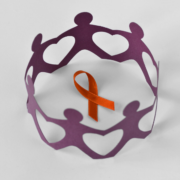Acute Myeloid Leukemia
What is Leukemia?
Leukemias are cancers that start in cells that would normally develop into different types of blood cells. It is a cancer of the body’s blood-forming tissues, including the bone marrow and the lymphatic system. Most often, leukemia starts in early forms of white blood cells, but some leukemias start in other blood cell types.
There are several types of leukemia, which are divided based mainly on whether the leukemia is acute (fast growing) or chronic (slower growing), and whether it starts in myeloid cells or lymphoid cells. The main types of leukemia include:
- Acute Lymphocytic Leukemia (ALL)
- Acute Myeloid Leukemia (AML)
- Chronic Lymphocytic Leukemia (CLL)
- Chronic Myelogenous Leukemia (CML)
- Other – Other, rarer types of leukemia exist, including hairy cell leukemia, myelodysplastic syndromes and myeloproliferative disorders
In this article we will be focusing on Acute Myeloid Leukemia (AML) since it is the most frequent acute leukemia in adulthood.
What is Acute Myeloid Leukemia?
Acute myeloid leukemia (AML) is a cancer of the blood in which the bone marrow makes abnormal cells. The “acute” in Acute Myeloid Leukemia denotes the disease’s rapid progression In AML, myeloid stem cells usually mature into abnormal myeloblasts, or white blood cells. But, they sometimes become abnormal red blood cells or platelets. As they multiply, they overwhelm the normal cells in the bone marrow and blood. The cancer cells can also spread to other parts of the body.
This type of cancer usually gets worse quickly if it is not treated. It is the most common type of acute leukemia in adults. AML can also be referred to as:
- Acute myelogenous leukemia
- Acute myeloblastic leukemia
- Acute granulocytic leukemia
- Acute nonlymphocytic leukemia
Types of Acute Myeloid Leukemia
Knowing the subtype of AML can be very important, as it sometimes affects both a patient’s outlook and the best treatment. Most types of AML are based on how mature (developed) the cancer cells are at the time of diagnosis and how different they are from normal cells. The different types of AML include:
The French-American-British (FAB) Classification
- M0 – Undifferentiated acute myeloblastic leukemia
- M1 – Acute myeloblastic leukemia with minimal maturation
- M2 – Acute myeloblastic leukemia with maturation
- M3 – Acute promyelocytic leukemia (APL)
- M4 – Acute myelomonocytic leukemia
- M4 eos – Acute myelomonocytic leukemia with eosinophilia
- M5 – Acute monocytic leukemia
- M6 – Acute erythroid leukemia
- M7 – Acute megakaryoblastic leukemia
World Health Organization (WHO) Classification
- AML with recurrent genetic abnormalities, meaning with specific chromosomal changes
- AML with multilineage dysplasia, or abnormalities in how the blood cells look
- AML, related to therapy that is damaging to cells, also called therapy-related myeloid neoplasm
- AML that is not otherwise categorized
- Myeloid sarcoma
- Myeloid proliferations related to Down Syndrome
- Undifferentiated or biphenotypic acute leukemias
Cytogenetics
AML can also be classified by the cytogenetic, or chromosome, changes found in the leukemia cells. Changes in certain chromosomes help diagnose cancer, plan treatment, or find out how well treatment is working. Chromosomal changes are commonly grouped according to the likelihood that treatment will work against the subtype of AML.
All chromosomes are numbered from 1 to 22. And, sex chromosomes are called “X” or “Y.” The letters “p” and “q” refer to the “arms” or specific areas of the chromosome. Some of the types of genetic changes found in AML include:
- A translocation, which means that a chromosome breaks off and reattaches to another chromosome
- Extra copies of a chromosome
- A deletion of a chromosome
Some of the most common chromosomal changes are grouped as follows:
- Favorable. Chromosomal changes associated with more successful treatment include abnormalities of chromosome 16 at bands p13 and q22 [t(16;16)(p13;q22), inv(16)(p13q22)] and a translocation between chromosomes 8 and 21 [t(8;21)].
- Intermediate. Changes associated with a less favorable prognosis include normal chromosomes, where no changes are found and a translocation between chromosomes 9 and 11 [t(9;11)]. Many other subtypes are considered part of this group, particularly those with 1 or more specific molecular changes. Sometimes, extra copies of chromosome 8 or trisomy 8 may be classified as intermediate risk over unfavorable (see below).
- Unfavorable. Examples of chromosomal changes that are associated with less successful treatment or with a low chance of curing the AML include extra copies of chromosomes 8 or 13 [for example, trisomy 8 (+8)], deletion of all or part of chromosomes 5 or 7, complex changes on many chromosomes, and changes to chromosome 3 at band q26.
Symptoms of AML
The signs and symptoms of AML vary based on the type of blood cell affected. They are generally nonspecific and warrant investigations for proper diagnosis. The signs and symptoms of AML are:
- Fever
- Pain in bones and joints
- Pale skin
- Easy bruising and contusions
- Recurrent infections
- Unusual bleeding, epistaxis, bleeding gums
Causes and Risk Factors for AML
Although the cause of AML is not known, several factors are associated with an increased risk of the disease. The following factors may raise a person’s risk of developing AML:
- Age – AML is becomes more common as people get older
- Being Male – AML is more common in males than in females
- Smoking – Cancer-causing substances in tobacco smoke are absorbed by the lungs and spread through the bloodstream to many parts of the body
- Genetics – Researchers are finding that leukemia may run in a family due to inherited gene mutation
- Chemicals – Long-term exposure to chemicals like benzene, found in petroleum, cigarette smoke, and industrial workplaces, raises the risk of AML
- Previous Cancer Treatment – People who have received chemotherapy and/or radiation therapy for other types of cancer, such as breast cancer, ovarian cancer, and lymphoma, have a higher risk of developing AML in the years following treatment.
- Other Bone Marrow Disorders – People who have other bone marrow diseases can develop AML over time
How is Acute Myeloid Leukemia Diagnosed?
No screening exams exist for leukemia.
Doctors often discover that a person has chronic leukemia through routine blood testing. They may also rely on their experience and current knowledge of the disease.
If your doctor suspects you may have leukemia, he or she will order specific diagnostic tests such as a:
- Blood test
- Bone marrow biopsy
- Spinal tap
- Genomic testing
Is Acute Myeloid Leukemia Hereditary?
Leukemia does not usually run in families, so in most cases, it is not hereditary. However, people can inherit genetic abnormalities that increase their risk of developing this form of cancer.
For example having a family history of other blood disorders increases your risk of getting AML. These disorders include:
- Polycythemia Vera
- Essential Thrombocythemia
- Idiopathic myelofibrosis.
Some syndromes that are caused by genetic mutations (abnormal changes) present at birth seem to raise the risk of AML. These include:
- Down syndrome
- Ataxia telangiectasia
- Li-Fraumeni syndrome
- Klinefelter syndrome
- Fanconi anemia
- Wiskott-Aldrich syndrome
- Bloom syndrome
- Familial Platelet Disorder syndrome
Newly Diagnosed AML Advice from an Expert
Dr. Elizabeth Bowhay-Carnes of UT Health San Antonio MD Anderson Cancer Center provides advice for patients facing an AML diagnosis, including:
- Understand who your care team is including the main attending physician and the main nursing contact/support person would be
- Designate a family member or friend to play the main supportive role
Preparing for Your AML Appointment
Your first appointment can be overwhelming and can be hard to grasp the realistic expectations of life during the AML treatment phase. Here are some tips and tricks to prepare you for your first appointment:
- Write down any and all questions you have before coming to the doctor’s office
- Bring a notepad to the appointment to jot down notes about what is said during the appointment or ask if you can record your visit
- Consider your values and expectations of your quality of life
- Keep copies of your medical records
- Bring a friend or a family member to your appointments to help you retain all the information discusses
- Consider all your treatment options, including any clinical trials available to you
Treating Acute Myeloid Leukemia
Treatment of AML depends on several factors, including the subtype of the disease, your age, your overall health and your preferences. The types of treatment include:
- Chemotherapy – the primary treatment options that uses chemicals to kill cancer cells
- Targeted therapy – medications that target cancer cells, but don’t affect healthy cells. This type of treatment usually has less side effects
- Other drug therapy
- Stem Cell transplant – also called a bone marrow transplant, helps re-establish health stem cells by replacing unhealthy bone marrow with leukemia-free stem cells that will regenerate health bone marrow
- Clinical trials – can involve therapy with new drugs and new drug combinations or new approaches to stem cell transplantation
it is often a good idea to seek a second opinion. A second opinion can give you more information and help you feel more confident about the treatment plan you choose.
What You Can Expect From AML Treatment
Based on your treatment options that you have discussed with your care team, it Is important you understand how treatment may affect you. Some things you should discuss with your care team and loved ones include:
- Your personal goals and values
- Results you can expect
- Potential side effects
- Palliative care
- How treatment may affect your life
- The financial costs of treatment
Recovery and Survival
Leukemia represents 3.5 percent of all new cancer cases in the United States, and it is the seventh leading cause of cancer death. The outlook for leukemia patients depends on which type of leukemia they have, their overall health, and their age.
In the case of AML, it makes up 32% of all adult leukemia cases and there will be about 19,940 new cases of AML in the United States this year. Remission in AML is usually defined when the bone marrow contains fewer than 5% blast cells. For most types of AML, about 2 out of 3 people with AML who get standard treatment go into remission. The 5-year survival rate for people 20 and older with AML is about 25%. For people younger than 20, the survival rate is 67%.
Sources:
“Treatment.” Acute Myeloid Leukemia Treatment | Leukemia and Lymphoma Society, 26 Feb. 2015, www.lls.org/leukemia/acute-myeloid-leukemia/treatment.
“Adult Acute Myeloid Leukemia Treatment (PDQ®)–Patient Version.” National Cancer Institute, www.cancer.gov/types/leukemia/patient/adult-aml-treatment-pdq.
“Acute Myeloid Leukemia (AML) Subtypes and Prognostic Factors.” American Cancer Society, www.cancer.org/cancer/acute-myeloid-leukemia/detection-diagnosis-staging/how-classified.html.
“Leukemia – Acute Myeloid – AML – Subtypes.” Cancer.Net, 18 Aug. 2017, www.cancer.net/cancer-types/leukemia-acute-myeloid-aml/subtypes.
“Leukemia Types, Symptoms, and Treatments.” UPMC HIllman Cancer Center, hillman.upmc.com/cancer-care/blood/types/leukemia.
“Treating Acute Myeloid Leukemia (AML).” American Cancer Society, www.cancer.org/cancer/acute-myeloid-leukemia/treating.html.
“Acute Myelogenous Leukemia.” Mayo Clinic, Mayo Foundation for Medical Education and Research, 27 Dec. 2017, www.mayoclinic.org/diseases-conditions/acute-myelogenous-leukemia/diagnosis-treatment/drc-20369115.
“Treatment Response Rates for Acute Myeloid Leukemia (AML).” American Cancer Society, www.cancer.org/cancer/acute-myeloid-leukemia/treating/response-rates.html.
“Leukemia – Acute Myeloid – AML – Statistics.” Cancer.Net, 19 Feb. 2020, www.cancer.net/cancer-types/leukemia-acute-myeloid-aml/statistics.




![[ACT]IVATED [ACT]IVATED logo](https://powerfulpatients.org/wp-content/uploads/ACTIVATED-180x180.png)





